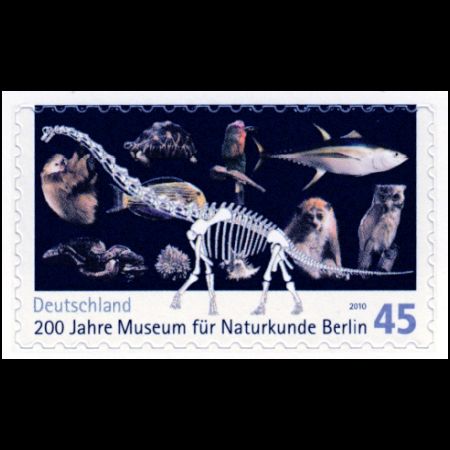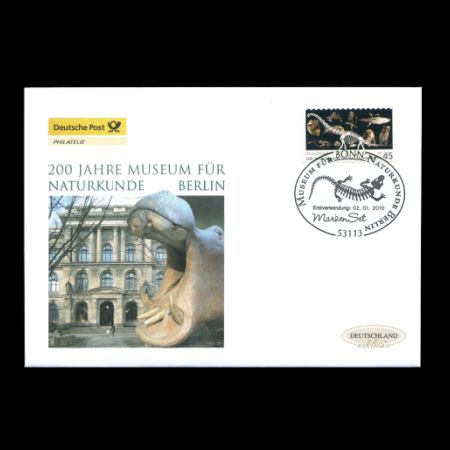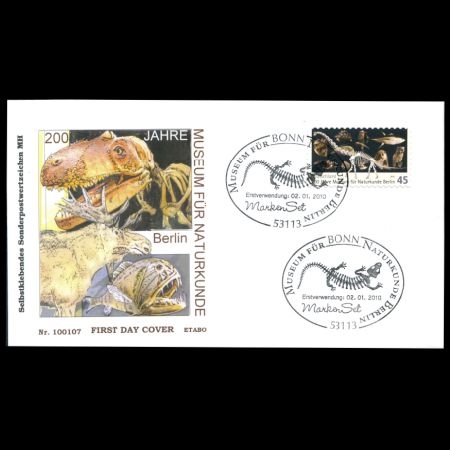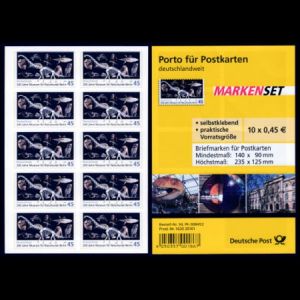Germany 2010 "Bicentenary of Museum fuer Naturkunde in Berlin" (self adhesive)
| Issue Date | 02.01.2010 |
| ID | Michel: 2780 Scott: Stanley Gibbons: Yvert: UPU: Category: pF |
| Author | Juenger + Michel, Berlin |
| Stamps in set | 1 |
| Value | Euro 0.45 (can be used on post card) |
| Size (width x height) | |
| Layout | MS of 10 stamps both mint and self-adhensive |
| Products | FDC x1 MS x2 |
| Paper | stroke, white, fluoresce, special post papper DP 2 |
| Perforation | die cut |
| Print Technique | Multicolor offset print |
| Printed by | Giesecke & Devrient GmbH, Wertpapierdruckerei Leipzig |
| Quantity | |
| Issuing Authority | Deutsche |

On January 2nd 2010, Post authority of Germany issued a stamp "Bicentenary of Nature Science Museum in Berlin" (Bicentenary of Museum fuer Naturkunde in Berlin). Design of the stamp selected in competition of various designers:

The stamp is printed out in two variation: mint and self-adhesive, bit smaller in size.

The museum of Nature
Science (Das Museum fuer Naturkunde ) in
Berlin is one of the biggest and important museums of the type in a
world. Spectacular artifact of the museum is 14 meter high the biggest
dinosaur skeleton of the world (see on the stamp). More than 1.5 Million
visitors a year visit an exhibitions of the museum with a main
focus on history of the Earth and the Life on it, variation of
the Life as well as Meteorit research.
Many scientist are use about 30 million items stored in the
museum, related to zoology, paleontology, and mineralogy for
their researches.
The major artifact of "Evolution in action" exhibition is original,
unique and famous fossil of prehistoric bird "Archaeopteryx
lithographica" - one of the most important fossils of the world.
Museum fuer Naturkunde Berlin is a research museum within the
Leibniz Association. It is one of the most significant research
institutions worldwide in biological and geo-scientific evolution
research and biodiversity.
The Collections of the Museum are directly linked to research. They
comprise more than 30 million items relating to zoology, palaeontology,
geology and mineralogy, which are highly significant for science as
well as for the history of science. This is due not only to the fact
that the collections have been compiled continuously for over 200
years, but also to some spectacular pieces such as:
* the Berlin specimen of the primeval
bird Archaeopteryx lithographica
* the dinosaurs from the Tendaguru
excavation site (including Brachiosaurus brancai)
* the original piece of uranium on which
its first scientific description was based
* the Bloch Collection from the 18th
century, probably the oldest preserved fish collection in the world
Most famous artifact of paleontologic part of the museum is 14 meter
long skeleton of Brachiosaurus brancai , depicting
on the stamp. The bones were
recovered by researchers at Tendaguru Hill ( 250 tonnes about) and
shipped to Berlin, where skeletons were put together.
| Official FDC | Personalized FDC |
 |  |
| Mini Sheet | Souvenir sheet of various self-adhesive stamps |
 |  |
References: Wikipedia Souvenir Sheet
 |
|
Latest update 01.11.2017
Any feedback, comments or even complaints are welcome: admin@paleophilatelie.eu (you can email me on ENglish, DEutsch, or RUssian)